View in other NatureServe Network Field Guides
NatureServe
Montana
Utah
Wyoming
Idaho
Wisconsin
British Columbia
South Carolina
Yukon
California
New York
Oregon Bluebells - Mertensia bella
State Rank Reason (see State Rank above)
Rare in Montana, where it is known only from the Lolo National Forest. Some disturbance may be beneficial or at least tolerated. Mining activity occurs near one site though it is unknown if this has had any impact on M. bella. Additional monitoring of the populations is needed to determine trends.
- Details on Status Ranking and Review
Population Size
Score1-2 - Small to Moderate. Population size is imprecisely known but is believed to be >2,000 individuals and <100,000 individuals.
CommentAvailable data varies widely in terms of number of individuals estimated.
Range Extent
Score1 - Peripheral, Disjunct or Sporadic Distribution in MT: Widespread species that is peripheral, disjunct or sporadically distributed within MT such that it occurs in <5% of the state (<7,500 sq. miles or the combined area of Beaverhead and Ravalli Counties) or is restricted to 4-5 sub-basins.
CommentPeripheral in western Montana.
Area of Occupancy
Score3 - Very Low: Generally occurring in 3 or fewer Subwatersheds (6th Code HUC’s).
Environmental Specificity
Score0-1 - Low to Moderate.
Trends
Score0-1 - Stable to Minor Declines:
CommentTrends unknown, though populations are likely stable or experiencing only minor declines.
Threats
Score1-2 - Medium to High.
CommentThreats such as timber harvesting and mining have been considered in separate reviews though it is unclear to what extent if any negative impacts to the species or its habitat may result from these or other activities.
Intrinsic Vulnerability
Score1 - Moderate Vulnerability: Specific biological attributes, unusual life history characteristics or limited reproductive potential makes the species susceptible to extirpation from stochastic events or other adverse impacts to its habitat and slow to recover.
Raw Conservation Status Score
Score
7 to 11 total points scored out of a possible 19.
General Description
Oregon Bluebells is a perennial herb with solitary stems that arise from a bulb-like root and that are 10-40 cm tall. The ovate leaves are thin, entire-margined, evidently veiny, and 38 cm long. The lowermost leaves are reduced to membranous sheaths, while the others have progressively reduced petioles upwards on the stem. The herbage is mostly glabrous. The blue flowers are stalked and borne in open inflorescences at the top of the stem and in the axils of the upper leaves. The lower two-thirds of the 5 petals are united into a bell-shaped corolla that is 6-10 mm long. The calyx is 2-3 mm long and sparsely hairy.
Phenology
Flowering in late May-June.
Diagnostic Characteristics
The bell-shaped flowers lack a distinctly constricted lower tubular portion separate from a flaring upper portion, distinguishing this species from all other Mertensia in our area.
Species Range
Montana Range
Range Descriptions
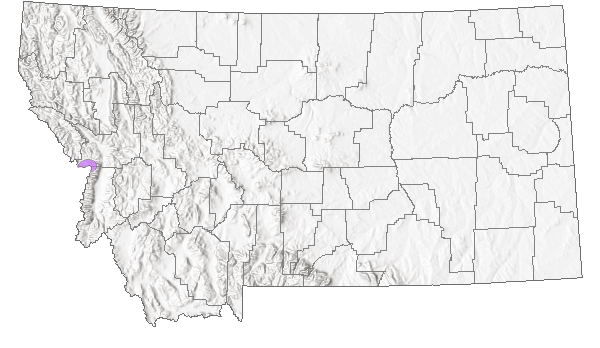
 Native
Native
Range Comments
Endemic to eastern OR, north ID, adjacent MT, disjunct in western OR. There is one location in Missoula County (Lesica et al. 2012. Manual of Montana Vascular Plants. BRIT Press. Fort Worth, TX).
Observations in Montana Natural Heritage Program Database
Number of Observations: 36
(Click on the following maps and charts to see full sized version)
Map Help and Descriptions
Relative Density
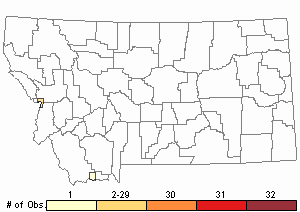
Recency
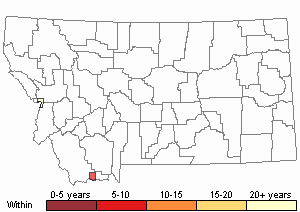
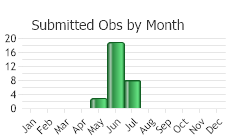
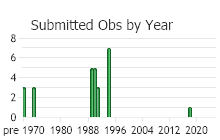
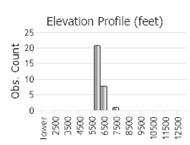 (Observations spanning multiple months or years are excluded from time charts)
(Observations spanning multiple months or years are excluded from time charts)
Habitat
Wet, seepy, open or partially shaded slopes in the montane and subalpine zones, often in mesic, forb dominated communities or openings in spruce-fir forests.
National Vegetation Classification System Groups Associated with this Species
Forest and Woodland
Montane - Subalpine Forest and Woodland
Grassland
Montane - Subalpine Grassland
Ecology
POLLINATORS The following animal species have been reported as pollinators of this plant species or its genus where their geographic ranges overlap:
Bombus vagans,
Bombus bifarius,
Bombus centralis,
Bombus flavifrons,
Bombus frigidus,
Bombus huntii,
Bombus melanopygus,
Bombus mixtus,
Bombus rufocinctus,
Bombus sylvicola,
Bombus occidentalis,
Bombus pensylvanicus,
Bombus bimaculatus,
Bombus griseocollis,
Bombus insularis, and
Bombus kirbiellus (Macior 1974, Bauer 1983, Thorp et al. 1983, Mayer et al. 2000, Colla and Dumesh 2010, Colla et al. 2011, Koch et al. 2012, Pyke et al. 2012, Miller-Struttmann and Galen 2014, Williams et al. 2014).
Stewardship Responsibility
Threats or Limiting Factors
STATE THREAT SCORE REASON
Reported threats to Montana's populations of Oregon Bluebells are currently assigned as unknown (MTNHP Threat Assessment 2021). Mining in the vicinity of a population is indicated, but these impacts are estimated relative to a timeframe exceeding 10 years. Information about expected impacts found in a 10-year timeframe are needed to assess relative contribution to populations threats.
References
- Literature Cited AboveLegend:
 View Online Publication
View Online Publication Bauer, P.J. 1983. Bumblebee pollination relationships on the Beartooth Plateau tundra of Southern Montana. American Journal of Botany. 70(1): 134-144.
Bauer, P.J. 1983. Bumblebee pollination relationships on the Beartooth Plateau tundra of Southern Montana. American Journal of Botany. 70(1): 134-144. Colla, S., L. Richardson, and P. Williams. 2011. Bumble bees of the eastern United States. Washington, DC: USDA Forest Service, Pollinator Partnership. 103 p.
Colla, S., L. Richardson, and P. Williams. 2011. Bumble bees of the eastern United States. Washington, DC: USDA Forest Service, Pollinator Partnership. 103 p. Colla, S.R. and S. Dumesh. 2010. The bumble bees of southern Ontario: notes on natural history and distribution. Journal of the Entomological Society of Ontario 141:39-68.
Colla, S.R. and S. Dumesh. 2010. The bumble bees of southern Ontario: notes on natural history and distribution. Journal of the Entomological Society of Ontario 141:39-68. Koch, J., J. Strange, and P. Williams. 2012. Bumble bees of the western United States. Washington, DC: USDA Forest Service, Pollinator Partnership. 143 p.
Koch, J., J. Strange, and P. Williams. 2012. Bumble bees of the western United States. Washington, DC: USDA Forest Service, Pollinator Partnership. 143 p. Lesica, P., M.T. Lavin, and P.F. Stickney. 2012. Manual of Montana Vascular Plants. Fort Worth, TX: BRIT Press. viii + 771 p.
Lesica, P., M.T. Lavin, and P.F. Stickney. 2012. Manual of Montana Vascular Plants. Fort Worth, TX: BRIT Press. viii + 771 p. Macior, L.M. 1974. Pollination ecology of the Front Range of the Colorado Rocky Mountains. Melanderia 15: 1-59.
Macior, L.M. 1974. Pollination ecology of the Front Range of the Colorado Rocky Mountains. Melanderia 15: 1-59. Mayer, D.F., E.R. Miliczky, B.F. Finnigan, and C.A. Johnson. 2000. The bee fauna (Hymenoptera: Apoidea) of southeastern Washington. Journal of the Entomological Society of British Columbia 97: 25-31.
Mayer, D.F., E.R. Miliczky, B.F. Finnigan, and C.A. Johnson. 2000. The bee fauna (Hymenoptera: Apoidea) of southeastern Washington. Journal of the Entomological Society of British Columbia 97: 25-31. Miller-Struttmann, N.E. and C. Galen. 2014. High-altitude multi-taskers: bumble bee food plant use broadens along an altitudinal productivity gradient. Oecologia 176:1033-1045.
Miller-Struttmann, N.E. and C. Galen. 2014. High-altitude multi-taskers: bumble bee food plant use broadens along an altitudinal productivity gradient. Oecologia 176:1033-1045. MTNHP Threat Assessment. 2021. State Threat Score Assignment and Assessment of Reported Threats from 2006 to 2021 for State-listed Vascular Plants. Botany Program, Montana Natural Heritage Program, Helena, Montana.
MTNHP Threat Assessment. 2021. State Threat Score Assignment and Assessment of Reported Threats from 2006 to 2021 for State-listed Vascular Plants. Botany Program, Montana Natural Heritage Program, Helena, Montana. Pyke, G.H., D.W. Inouye, and J.D. Thomson. 2012. Local geographic distributions of bumble bees near Crested Butte, Colorado: competition and community structure revisited. Environmental Entomology 41(6): 1332-1349.
Pyke, G.H., D.W. Inouye, and J.D. Thomson. 2012. Local geographic distributions of bumble bees near Crested Butte, Colorado: competition and community structure revisited. Environmental Entomology 41(6): 1332-1349. Thorp, R.W., D.S. Horning, and L.L. Dunning. 1983. Bumble bees and cuckoo bumble bees of California (Hymenoptera: Apidae). Bulletin of the California Insect Survey 23:1-79.
Thorp, R.W., D.S. Horning, and L.L. Dunning. 1983. Bumble bees and cuckoo bumble bees of California (Hymenoptera: Apidae). Bulletin of the California Insect Survey 23:1-79. Williams, P., R. Thorp, L. Richardson, and S. Colla. 2014. Bumble Bees of North America. Princeton, NJ: Princeton University Press. 208 p.
Williams, P., R. Thorp, L. Richardson, and S. Colla. 2014. Bumble Bees of North America. Princeton, NJ: Princeton University Press. 208 p.
- Additional ReferencesLegend:
 View Online Publication
View Online Publication
Do you know of a citation we're missing? Lesica, P., M.T. Lavin, and P.F. Stickney. 2022. Manual of Montana Vascular Plants, Second Edition. Fort Worth, TX: BRIT Press. viii + 779 p.
Lesica, P., M.T. Lavin, and P.F. Stickney. 2022. Manual of Montana Vascular Plants, Second Edition. Fort Worth, TX: BRIT Press. viii + 779 p. Lichthardt, J.J. 1992. Report on the conservation status of Mertensia bella (Oregon bluebells) in Idaho. Unpublished report. Idaho Department of Fish and Game. Boise, Idaho 43 pp.
Lichthardt, J.J. 1992. Report on the conservation status of Mertensia bella (Oregon bluebells) in Idaho. Unpublished report. Idaho Department of Fish and Game. Boise, Idaho 43 pp. Lorain, C. C. 1988. Floristic history and distribution of coastal disjunct plants of the northern Rocky Mountains. M.S. thesis. College of Forestry, Wildlife, and Range Sciences, University of Idaho, Moscow. 221 pp.
Lorain, C. C. 1988. Floristic history and distribution of coastal disjunct plants of the northern Rocky Mountains. M.S. thesis. College of Forestry, Wildlife, and Range Sciences, University of Idaho, Moscow. 221 pp. Roe, L.S. 1991. Status review of Mertensia bella, USDA Forest Service, Region 1, Lolo National Forest, Montana. Unpublished report to the Lolo National Forest. Montana Natural Heritage Program. Helena, MT. 27 pp.
Roe, L.S. 1991. Status review of Mertensia bella, USDA Forest Service, Region 1, Lolo National Forest, Montana. Unpublished report to the Lolo National Forest. Montana Natural Heritage Program. Helena, MT. 27 pp. Williams, L.O. 1937. A monograph of the genus Mertensia in North America. Annals of the Missouri Botanical Garden 14:17-159.
Williams, L.O. 1937. A monograph of the genus Mertensia in North America. Annals of the Missouri Botanical Garden 14:17-159.
- Web Search Engines for Articles on "Oregon Bluebells"





